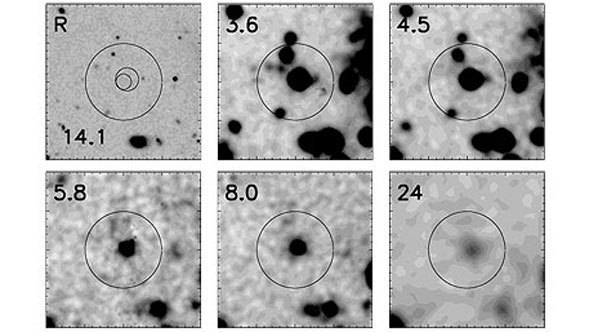
News Release • March 31st, 2006 • feature06-08 •
Written by Linda Vu
Spitzer Science Center
Paper trails and DNA tests will not help nearby elliptical galaxies find their galactic ancestors. However, an identification technique recently developed by astronomers using NASA's Spitzer Space Telescope is proving to be very successful in recognizing what could be the predecessors of modern elliptical galaxies.
The technique involves pointing Spitzer's Infrared Array Camera (IRAC) and Multi-band Imaging Photometer (MIPS) at areas of the sky where ground-based telescopes sensitive to sub-millimeter light have previously spotted a species of mysteriously faint, distant, infant galaxies. These galaxies are rapidly forming stars at rates of hundreds per year. In comparison, our Milky Way galaxy produces about one star per year.
After observing the regions with Spitzer, astronomers can detect the faint hyperactive galaxies from a sea of other galaxies seen in the infrared images by looking at their infrared colors.
"This technique is possible only because of Spitzer's unique combination of great spatial resolution and its unprecedented sensitivity at infrared wavelengths," said Dr. Matthew Ashby of the Harvard-Smithsonian Center for Astrophysics, Cambridge, Mass. Ashby is the lead author of a paper describing the new observing technique, which will be published in the June 2006 issue of the Astrophysical Journal.
According to Ashby, the peculiarly active baby galaxies, also known to astronomers as "SCUBA galaxies," are located approximately 10 billion light-years away or further, and don't exist anywhere in the local universe. The galaxies are nicknamed after the ground-based instrument that first discovered them almost a decade ago, the Sub-millimeter Common-User Bolometer Array (SCUBA) on the James Clerk Maxwell Telescope atop Mauna Kea in Hawaii.
The original sub-millimeter surveys detected hundreds of the mysterious star-forming galaxies, but because those surveys lacked the precision -- what astronomers call spatial resolution -- to pin down the galaxies' locations precisely, astronomers have had difficulty finding the SCUBA galaxies at other wavelengths. Until now, the only way to obtain accurate positions was with follow-up surveys using sensitive ground-based radio telescopes. However, this has been a problem because radio telescopes only captured about half of the distant galaxies that sub-millimeter instruments originally detected.
Furthermore, identifying SCUBA galaxies been extremely difficult because the dust from rapid star formation has blocked much of their starlight from view. In visible-light observations, SCUBA galaxies are very faint, almost invisible.
But when Ashby's team used images taken by Spitzer's IRAC and MIPS instruments to identify SCUBA galaxies based on their infrared colors, they detected almost all of the SCUBA galaxies originally captured by the sub-millimeter telescope, including most of the objects that radio telescopes did not see.
"With Spitzer we were even able to see five or six SCUBA galaxies hosting supermassive black holes in addition to the incredibly rapid star formation that's going on in them," said Ashby.
The distance of SCUBA galaxies at 10 billion light-years corresponds to an epoch when the universe was approximately 3 billion years old, or roughly one-fourth its current age of 13.7 billion years. Since nearby elliptical galaxies are primarily made up of "old stars" that are billions of years old -- in some cases, more than half as old as the universe -- many scientists suspect that SCUBA galaxies may be the predecessors of nearby elliptical galaxies.
"SCUBA galaxies are seen in an era that seems to be the peak of star formation in the universe," said Ashby. "We don't see anything like them in the nearby universe and if the connection between modern elliptical galaxies and SCUBA galaxies can be proved, it would be a very interesting result."
"There are still a lot of unanswered questions pertaining to SCUBA galaxies? but for folks who really want to understand what SCUBA galaxies are, this Spitzer technique is a significant achievement," he added.
In 2004, a team of astronomers led by Dr. Stephen Serjeant of the University of Kent, Canterbury, UK, used Spitzer's IRAC and MIPS instruments to determine that SCUBA galaxies are partly responsible for the haze of sub-millimeter light found across the universe.
In a companion paper to Ashby's, lead author Dr. Simon Dye of Cardiff University in Wales, UK, used Spitzer data to determine just how much sub-millimeter light SCUBA galaxies contribute to the haze. Dye's paper will also be published in the June 2006 issue of Astrophysical Journal.
In addition to Ashby and Dye, other authors on the paper include: Jiasheng Huang, Stephen Eales, Steve Willner, Tracy Webb, Pauline Barmby, Dimitra Rigopoulou, Eiichi Egami, Henry McCracken, Simon Lilly, Satoshi Miyazaki, Mark Brodwin, Myra Blaylock, Jim Cadien, and Giovanni G. Fazio.





